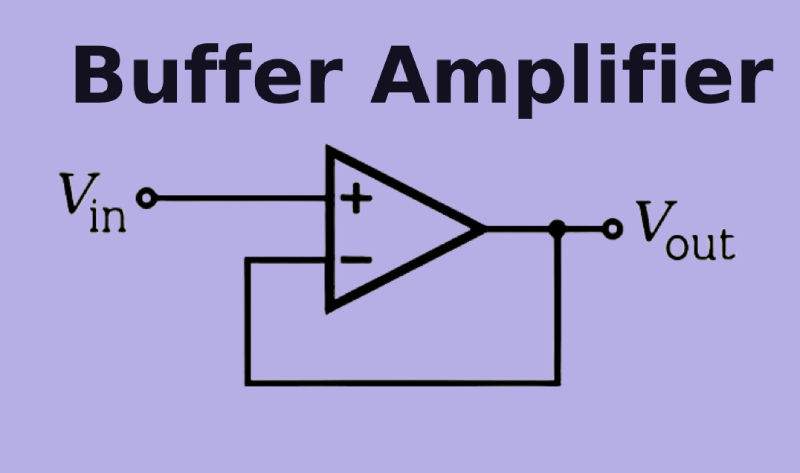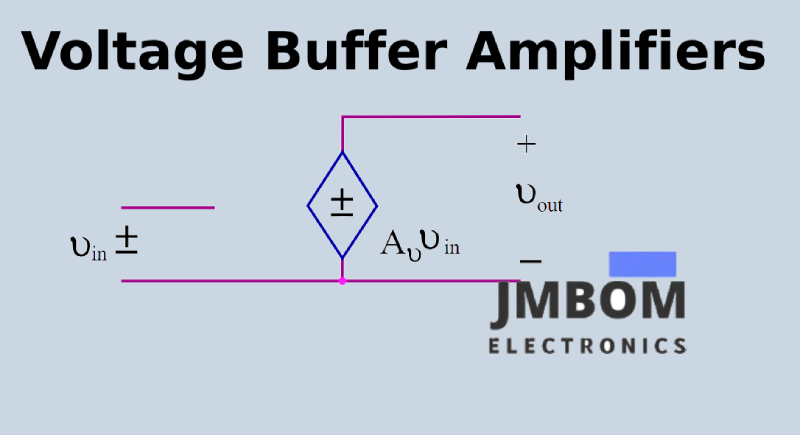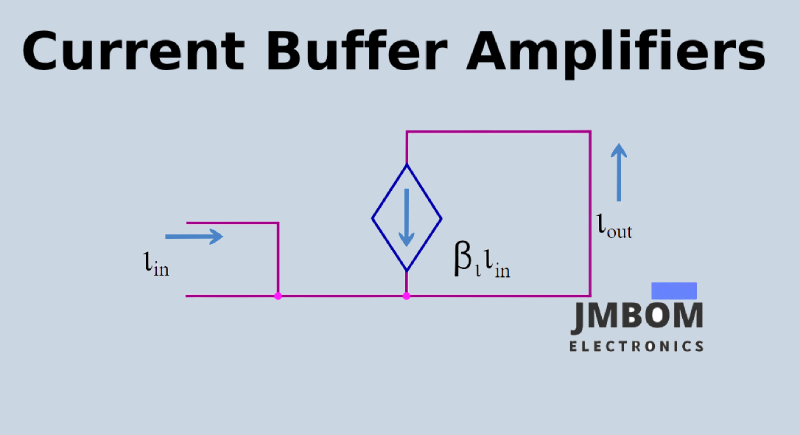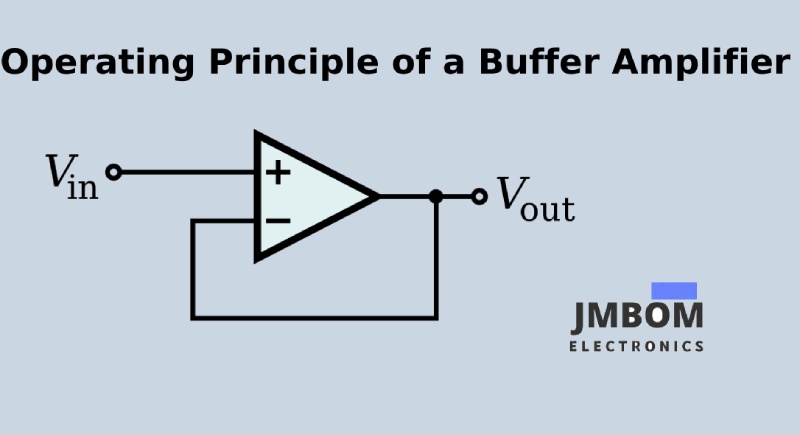

Buffer Amplifier: Types, Operating Principles, and Uses
Catalog
What Is a Buffer Amplifier?Types of Buffer AmplifiersDisadvantages and Advantages of Buffer AmplifiersApplications of Buffer AmplifiersAdditional Applications of Buffer AmplifiersFinal VerdictFrequently Asked Questions (FAQ)Related ArticlesWhen connecting two electronic circuits, differences in impedance can lead to signal degradation or distortion. Furthermore, mismatched voltage levels or high current demands from one circuit can create unwanted loading effects. Buffer amplifiers are specifically built to address these challenges. They are especially important in signal-processing tasks and serve a vital function in modern electronics. In this guide, we’ll take a closer look at how buffer amplifiers work, the different types available, and where they’re commonly used.
What Is a Buffer Amplifier?
A buffer amplifier is a type of amplifier that not only strengthens voltage and impedance signals but also helps manage the transition between different circuit stages. Its main role is to isolate these stages, ensuring that one part of a circuit doesn’t negatively affect another. Thanks to its high input impedance and low output impedance, a buffer amplifier can receive signals from high-impedance sources without introducing noticeable distortion. This makes it essential for maintaining signal quality throughout complex electronic systems.
Buffer amplifiers are widely used in audio systems, measurement instruments, and data acquisition setups. In audio electronics, they help preserve sound quality by separating the preamp and power amp stages. In precision measurement systems, they prevent loading effects that could affect accuracy. They’re also valuable in analog-to-digital conversion, where they bridge the impedance gap between analog sensors and digital converters. Given their importance in preserving signal integrity and ensuring reliable operation, buffer amplifiers are key components in today’s electronic designs.

Types of Buffer Amplifiers
Voltage Buffer Amplifiers
Also known as voltage followers, voltage buffer amplifiers are used to pass signals from one stage of a circuit to the next while preserving signal strength. They feature high input impedance and low output impedance, allowing them to isolate different stages effectively. The high input impedance prevents the previous stage from being loaded down, while the low output impedance ensures the next stage receives the signal without degradation.
Key Characteristics:
- Unity Gain: These amplifiers have a gain of 1, meaning the output voltage is equal to the input voltage.
- High Input Impedance: This reduces current draw from the input source, minimizing any loading effects on the previous stage.
- Low Output Impedance: This enables the buffer to drive low-impedance loads while maintaining signal integrity.

Current Buffer Amplifiers
Current buffer amplifiers deliver high current gain while maintaining the same voltage levels at both input and output. They allow a small input signal to control a much larger output current without significantly altering the input voltage, making them ideal for driving current-demanding stages.
Key Characteristics:
- High Current Gain: These amplifiers can significantly boost output current based on a relatively small input.
- Low Input Impedance: This allows them to draw enough current from the source to operate effectively.
- High Output Impedance: This helps maintain stable current gain and ensures consistent output relative to the input current.

Operating Principle of a Buffer Amplifier
At the heart of a buffer amplifier is an operational amplifier (op-amp), configured as a non-inverting amplifier with unity gain. Op-amps are high-gain differential amplifiers with inverting and non-inverting inputs and a single output. In a buffer amplifier, the op-amp is set up in a way that the output directly follows the input voltage—without amplifying or altering its amplitude.
The non-inverting input of the op-amp receives the input signal, while the output is connected directly back to the inverting input through a feedback loop. This feedback forces the voltage at both inputs to be nearly equal. As a result, the output voltage exactly mirrors the input voltage, preserving the signal's original phase and amplitude. This configuration is what gives the buffer amplifier its unity gain (a gain of 1).
Thanks to the op-amp’s high open-loop gain, even a very small voltage difference between the inputs is quickly corrected through feedback. This ensures that the inverting input follows the non-inverting input closely, resulting in stable and accurate signal transmission. The buffer thus acts as a transparent bridge between circuit stages—delivering the same voltage at its output while protecting signal integrity and isolating impedance.

Disadvantages and Advantages of Buffer Amplifiers
Advantages of Buffer Amplifiers
- Bridges Impedance Differences: Effectively connects circuit sections with mismatched impedance without degrading signal quality.
- Maintains Signal Integrity: Preserves the original signal shape and prevents distortion when transitioning between stages.
- Protects Signal Sources: Shields low-power or sensitive input sources from being overloaded by the output stage.
- Enhances Power Transfer: Efficiently delivers current to the next stage, ensuring minimal power loss.
- Isolates Circuit Stages: Provides electrical separation between input and output, reducing the risk of interference or feedback.
- Delivers Consistent Output: Keeps voltage stable even as load conditions change, supporting reliable circuit performance.
Disadvantages of Buffer Amplifiers
- No Voltage Gain: Buffer amplifiers do not boost voltage; the output voltage is equal to the input.
- Requires External Power: Needs a power supply to operate, even though it doesn’t increase voltage levels.
- Adds to Circuit Complexity: May introduce unnecessary components in simple circuits, increasing design complexity.
- Limited High-Frequency Response: At very high frequencies, buffer performance may degrade, introducing delays or losses.
- Risk of Oscillation: If not properly designed, poor layout or feedback paths can cause instability or unwanted noise.
Applications of Buffer Amplifiers
1. Signal Transmission and Distribution
- Audio and Video Systems: Buffer amplifiers are commonly used in AV equipment to transmit signals without degradation. Their low output impedance and minimal capacitance help prevent signal loss caused by cable resistance and capacitance, preserving audio and video quality over longer distances.
- Telecommunications: In telecom systems, buffer amplifiers maintain signal strength and integrity across extended transmission paths. They ensure consistent performance even when signals travel over long cables or multiple distribution points.
- Data Communication: Buffer amplifiers help manage differences in voltage levels and impedance in data transmission systems. By stabilizing the signal, they enable smooth and reliable communication between digital devices.
2. Instrumentation and Measurement
- Sensor Interfaces: Buffer amplifiers serve as the interface between sensors and measurement electronics. Their high input impedance ensures the sensor isn’t loaded down, while their low output impedance effectively drives subsequent stages of the circuit.
- Signal Conditioning: In precise measurement systems, weak or sensitive signals from sensors or transducers are buffered before further processing. This improves signal clarity and accuracy for more reliable readings.
3. Audio Equipment
- Preamplifiers: Audio buffer amplifiers are used in the preamp stage to handle delicate audio signals before they reach the main amplifier. This isolation helps maintain signal purity and reduces the risk of distortion.
- Line Drivers: These amplifiers boost audio signals to levels strong enough to drive speakers or external amplifiers. They preserve sound fidelity and minimize signal interference during transmission.
Additional Applications of Buffer Amplifiers
Power Amplifier Protection
- Speaker Protection Circuits: Buffer amplifiers can shield the sensitive input stages of power amplifiers from sudden voltage or current spikes that may occur during startup or system faults, helping to prevent potential damage.
Feedback Networks
- Feedback Loops: Buffers are often integrated into the feedback paths of operational amplifier (op-amp) circuits. They help maintain consistent gain and impedance, ensuring the amplifier remains stable and linear while also regulating bandwidth.
RF (Radio Frequency) Applications
- Antenna Matching: In RF circuits, buffer amplifiers assist in achieving proper impedance matching between the antenna and circuitry, maximizing power transfer and minimizing signal reflections.
- RF Signal Processing: Buffers are frequently used to maintain signal strength and protect against impedance mismatches, which can distort RF signals during processing.
Industrial Control Systems
- Control Signal Transmission: In electrically noisy industrial environments, buffer amplifiers help ensure that control signals are transmitted clearly and reliably, minimizing the risk of interference or data loss.
Biomedical Instrumentation
- Medical Devices: Buffers are essential in devices like ECG and EEG systems. They isolate and protect both the patient and the sensitive measurement electronics, ensuring clean, accurate acquisition of weak biological signals.
Microprocessor Interfaces
- Logic Level Conversion: Buffer amplifiers are used to bridge voltage differences between microcontrollers or digital logic circuits, ensuring compatibility and stable data transmission across various logic levels.
High-End Audio Systems
- Tube Amplifiers: In premium audio setups, buffer stages are used to isolate and protect tube amplifiers from external variations. They also help drive low-impedance loads effectively, preserving sound fidelity and amplifier performance.
Final Verdict
Buffer amplifiers play a critical role in preserving signal integrity by isolating different sections of an electronic circuit. There are two primary types: voltage buffer amplifiers and current buffer amplifiers. Voltage buffers feature high input impedance and low output impedance, helping to prevent signal degradation and minimize loading on the source. In contrast, current buffers are ideal for isolating circuit stages with differing current demands, offering stable performance thanks to their high output impedance.
At the heart of most buffer amplifiers are operational amplifiers (op-amps), which ensure that the output accurately follows the input signal—providing strong drive capability without altering the signal’s original characteristics.
Buffer amplifiers are widely used in audio systems, measurement devices, and sensor interfaces. They’re especially valuable in applications where minimizing signal loss and avoiding interaction between circuit stages are crucial. In today’s complex electronic designs, buffer amplifiers are indispensable for ensuring stable operation and preventing impedance mismatches.
Frequently Asked Questions (FAQ)
What is the primary function of a buffer amplifier?
A buffer amplifier relays signals between circuit stages without altering the voltage, while protecting low-power signal sources from being affected by heavier loads.
Does a buffer amplifier boost the signal voltage?
No. A buffer amplifier keeps the voltage level constant between input and output. Its main role is to enhance the current-driving capability, not to amplify voltage.
Which transistor is commonly used in emitter follower buffer circuits?
Emitter follower buffers typically use bipolar junction transistors (BJTs), where the output is taken from the emitter terminal.
Can buffer amplifiers help extend battery life in portable electronics?
Yes. By reducing the load on sensitive signal sources, buffer amplifiers improve energy efficiency, which can contribute to longer battery life.
Is it possible to use multiple buffer amplifiers in one circuit?
Absolutely. Cascading buffer stages is a common technique for preserving signal integrity across long transmission paths or between complex circuit blocks.
Related Articles
PIC Microcontroller Programming for Your Electronics Project
Fiber Optic Sensors: Types and Real-World Uses
ADC (Analog-to-Digital Converter) Module in PIC Microcontrollers
Types of Microcontroller Boards and Their Uses
What is a Fuse: Different Types and Its Applications
How to Use a Transistor as a Switch
How Photoresistors Work, Types, and Common Uses
Various Types of Sensors Used in Modern Vehicles
Essential Impedance Formula Handbook for Electrical Engineers
Subscribe to JMBom Electronics !













